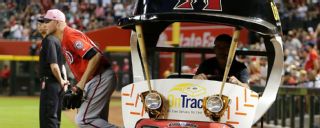|
Over the past 18 months, baseball commissioner Rob Manfred has been all but begging major league players for ideas and input on ways to make the product better. He seems ready to discuss even radical ideas, whether it’s some restrictions on defensive shifts, a pitch clock or maybe -- eventually -- an electronic strike zone. Here’s a fundamental change that would improve the game on many levels: Limit managers to the use of four pitchers per nine innings, with exceptions built in for injuries and blowouts. Major league baseball desperately needs to get off the growing front-office addiction to relief pitchers, which is helping to destroy important components of the game. Among those: the essential pre-eminence of starting pitchers, who need to be marquee-worthy not only for the teams and their marketing departments but also for the players’ union; the scoring of runs by means other than a home run; and batters making contact and putting the ball in play. None of this is meant to challenge the analytical wisdom behind the parade of relievers overrunning the sport. It's been demonstrated beyond any doubt that there are statistical advantages in the growing number of reliever/batter matchups and in the strategy of yanking the starting pitcher before he's exposed to the opposing lineup a third time. Smart people are making smart decisions to create effective seven- and eight-man bullpens. But this trend is affecting the game in ways that will never attract the young fans baseball wants and could also alienate longtime fans. Few starting pitchers concern themselves with getting through five or six innings these days. Rather, they're increasingly trained to throw as hard as they can, and when their work is finished, they're followed by relay teams of relievers who also throw really, really hard. The number of pitches of 96-plus mph has more than tripled in a span of just four years, and quite frankly, a lot of hitters -- especially older hitters -- are getting crushed. The number of strikeouts has skyrocketed, and batting average and pace of action are both way down as more and more pitchers are used. Researcher Sarah Langs of ESPN Stats & Information dug out these numbers: Pitchers per game (per team) past 10 seasons
2018: 4.25
2017: 4.22
2016: 4.15
2015: 4.11
2014: 3.98
2013: 3.95
2012: 3.99
2011: 3.86
2010: 3.87
2009: 3.93 The spike in reliever use over the past 25 years is extraordinary. Number of pitchers per game (per team)
2018: 4.25
2008: 3.92
1998: 3.46
1988: 2.75
1978: 2.40
1968: 2.47
1958: 2.44
1948: 2.23
1938: 1.89
1928: 1.83
1918: 1.50
1908: 1.40 To repeat something I wrote earlier this year: MLB needs starting pitchers to be the Paul Bunyans of the sport. The lure of the pitching matchup always has been incredibly important. Pedro vs. Clemens. Big Unit vs. Maddux. Scherzer vs. Kershaw. The starting pitchers always have been the headliners, a reason why a casual fan might tune in to see Mark Fidrych, or Koufax vs. Marichal, or Madison Bumgarner. The union needs this as well because starting pitchers generally have driven the salary structure for their pitching peers. When Kershaw or David Price or Justin Verlander or Felix Hernandez is paid well, there is a trickle-down effect for everyone else.  But as starting pitchers are asked to do less, throw less and are diminished in importance, salary numbers will decline. Yu Darvish got $126 million for six years from the Cubs, and already there are questions in the industry about whether Chicago stretched too far for a pitcher who hasn’t consistently reached the seventh inning in the past. But as starting pitchers are asked to do less, throw less and are diminished in importance, salary numbers will decline. Yu Darvish got $126 million for six years from the Cubs, and already there are questions in the industry about whether Chicago stretched too far for a pitcher who hasn’t consistently reached the seventh inning in the past.
The starting pitcher used to be The Man. But more and more, the starting pitcher is a guy. Among many guys. Just a decade ago, 36 pitchers threw 200 or more innings. Last year, there were 15. If managers could use only four pitchers in a nine-inning game, they would need more from their starters. The starting pitcher would regain his importance, and that would be good for the product, and good for the union. A limit of four pitchers per nine innings would also really help the hitters, who really need help these days. “How about we do something for the hitters for a change?” one official asked rhetorically earlier this season. Hitters might be more likely to see the starting pitcher a third time, and would be more likely to avoid the reliever matchup designed specifically for him. Presumably, with fewer pitchers available for each outing, the average velocity would decline, which might especially help hitters on the down slope of their careers. We recently detailed how a lot of hitters 30 and older are getting chewed up by the rapid increase in velocity. “I’m beginning to think that the age when you can’t really think about a multiyear deal is about 32,” one scout said recently. “These guys have a terrible time with the hard stuff.” The Mets’ Jay Bruce, 31, is an example of this. Evaluators say he has been overwhelmed by fastballs, and the numbers bear this out: The fact of the matter is that as most hitters age, they lose reaction time. And if more hard-throwing relievers are deployed, throwing harder than ever, a lot of older hitters are going to be bulldozed. I asked one manager about the possible limit of four pitchers over nine innings, and he immediately blanched. “You’re talking about years of tradition,” he said. “I would want more choices than that.” Of course. But with a limit, a whole new set of choices would be created. How long should the manager try to extend the starting pitcher? How quickly would a manager wait before pulling a struggling starter or reliever, knowing the limits in place? Managers would be challenged in different ways, forced to make the best of pared-down resources. What would end, hopefully, would be the nightly paint-by-numbers pitching changes, which can be excruciating to watch, with some managers calling on six or seven relievers (or even more than that in September when rosters expand), backed by front offices constantly promoting and demoting relievers to and from the minors to feed the addiction to the statistical edge in the specific matchups. Within the four-pitcher proposal put forth here, injured pitchers could be replaced midgame, of course, possibly with the caveat that they would have to serve a minimum period of time on the disabled list. And if a deficit for a team grew to eight runs or more, then managers could use more than four pitchers. Some managers and coaches privately hate watching the parade of relievers but feel they have no choice but to implement the strategy because the numbers are the numbers, and if they lose while eschewing a lefty vs. lefty matchup, they’ll have to answer questions from the media and their front-office bosses about why they wouldn’t tap into a statistical advantage, however slight. By adopting a four-pitcher limit, Manfred would save the front offices and managers from themselves and their own numbers. Rehab is needed. If the long procession of relievers is a good thing for the game, why isn’t anyone begging to open up the rosters to 50 and a couple of dozen pitchers? Answer: Because nobody wants to watch that. Tony Gwynn’s college coach, Jim Dietz of San Diego State, worked to glean the slightest statistical advantage every chance he could. I once covered an Aztecs tripleheader in which Dietz activated many left-handed relievers -- six to eight, if memory serves -- and throughout that long day, he called on his bullpen repeatedly. Every lefty hitter, it seemed, was met by a new lefty reliever. It was a little fascinating to see the strategy play out, but mostly it was awful, a boring string of pitching changes that went on and on and on. This is the direction baseball is headed -- driven there by numbers that make sense -- unless the current trajectory is altered. And a limit of four pitchers per nine innings would be one way to do that.
|

